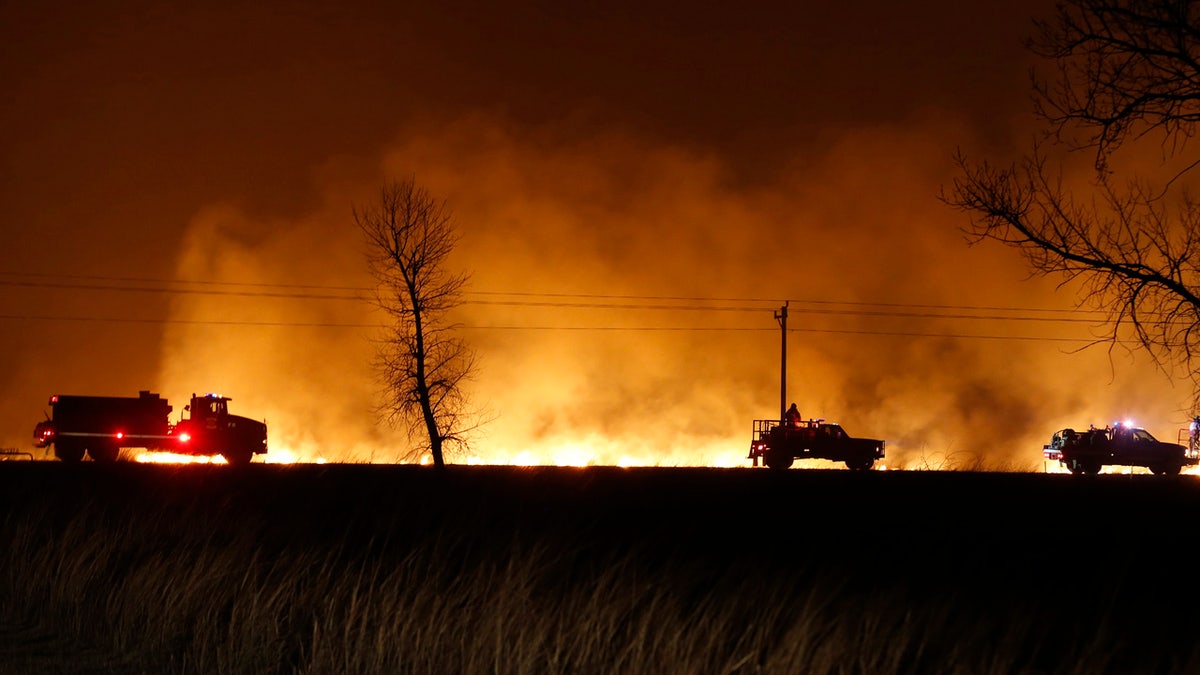
Firefighters from across Kansas and Oklahoma battle a wildfire near Protection, Kan., Monday, March 6, 2017. (Bo Rader/The Wichita Eagle via AP) (The Wichita Eagle)
Oklahoma's governor declared a state of emergency Tuesday in response to wildfires that have charred hundreds of square miles of land in four states and killed six people.
Gov. Mary Fallin issued the declaration for 22 of the state's 77 counties, including Beaver County, where fires have burned an estimated 390 square miles; and Harper County, where officials say a separate fire has scorched more than 155 square miles and was a factor in the death of a woman who had a heart attack while trying to keep her farm near Buffalo from burning.
Bill Bunting, forecast operations chief for the Oklahoma-based Storm Prediction Center, said Wednesday the powerful wind gusts that have helped the wildfires spread quickly in Kansas, Colorado, Oklahoma and Texas should die down to about 10 to 20 mph on Wednesday. He said temperatures should top off in the 70s, with afternoon humidity low.
"These conditions will make it somewhat easier for firefighting efforts, but far from perfect. The fires still will be moving," Bunting told The Associated Press. "The ideal situation is that it would turn cold and rain, and unfortunately that's not going to happen."
Related stories...
Fires raged in parts of Kansas, Oklahoma, Texas and Colorado, and warnings that conditions were ripe were issued for Iowa, Missouri and Nebraska. The fire warning came after powerful thunderstorms moved through the middle of the country overnight, spawning dozens of suspected tornadoes, according to the National Weather Service.
Kansas wildfires have burned about 625 square miles of land and killed one person. The Kansas Highway Patrol said Corey Holt, of Oklahoma City, died Monday when his tractor-trailer jackknifed as he tried to back up because of poor visibility on a southern Kansas highway, and he succumbed to smoke after getting out of his vehicle. Two SUVs crashed into the truck, injuring six people who were taken to hospitals, state trooper Michael Racy said.
The vast majority of the state's burned land is in Clark County, where 30 structures were damaged, said Allison Kuhns, a spokeswoman for the county's emergency management office. About half of those structures are near the small city of Englewood, which was one of two communities evacuated. Kuhns said there also have been significant cattle losses and that entire ranches were engulfed.
The largest evacuations elsewhere were in Reno County, Kansas, where 10,000 to 12,000 people voluntarily left their homes Monday night, said Katie Horner, a spokeswoman for the state's Department of Emergency Management. She said 66 people from the area were in shelters Tuesday in Hutchinson, 40 miles northwest of Wichita.
Among them was Shelley Wilson, who fled Monday with her disabled son and pets from a blaze that was encircling her farm outside of Hutchinson. She returned later that night with her adult daughter to retrieve her tractor.
"I don't know if I have a home to go home to," Wilson said at the shelter Tuesday as her daughter did her best to lighten her mood. "In case I needed to rebuild, I wanted to at least have my tractor."
Retiree Sheryl Stessen said she grabbed her cat and bolted from her apartment on the outskirts of Hutchinson when she saw the fire quickly go from looking like a puff of smoke to a big, orange ball.
"Most of us are generally grumpy," she said Tuesday. "I just want to go home."
Several hundred more people evacuated their homes in Russell, Ellsworth and Comanche counties, in central Kansas.
In the Texas Panhandle, three fires have burned about 500 square miles of land and killed at least four people. One of the blazes near Amarillo threatened about 150 homes, while a larger fire in the northeast corner of the Panhandle near the Oklahoma border was 50 percent contained as of late Tuesday morning, according to Texas A&M Forest Service. That larger fire was responsible for a death on Monday, authorities said Tuesday without providing further details.
A wildfire in Gray County, also in the Texas Panhandle, killed three ranch hands who were trying to usher cattle away from the flames, said Judge Richard Peet, the county's head administrator. One of the three apparently died of smoke inhalation Monday night and the other two were badly burned and died on the way to hospitals, he said.
Forest Service spokesman Phillip Truitt said as many as four firefighters were hurt battling the fires Monday. He provided no details on their conditions Tuesday morning.
In northeastern Colorado near the Nebraska border, firefighters were battling a blaze that had burned more than 45 square miles and was 50 percent contained Tuesday. Officials said the fire had destroyed at least five homes and 15 outbuildings, though no serious injuries were reported.
Dry conditions and strong winds had put the region at risk for wildfires, said Denise Gutzmer, a drought impact specialist for the National Drought Mitigation Center at the University of Nebraska in Lincoln.
The amount of Kansas and Oklahoma in what's classified as modified or severe drought also has intensified, with the entire eastern half of Colorado in various degrees of drought, according to the Nebraska center, which tracks U.S. drought conditions weekly.
In Kansas' case, after several years of drought, most of the state got good to great rain the last two summers, which is good for cattle but bad for firefighters, as the taller grass provides more fuel to burn.
The Associated Press contributed to this report.

